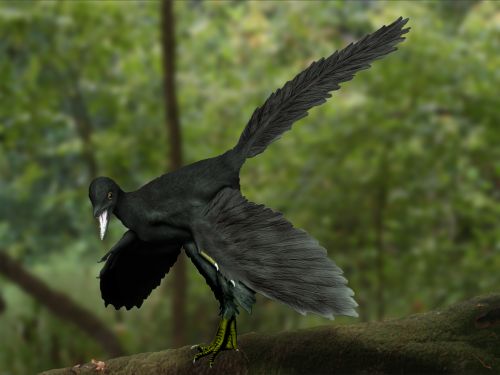Archaeopteryx, the ‘first bird’, has fascinated people since the first mostly complete specimen was dug out of a quarry in Bavaria in 1861.
Along with a number of other dinosaurs and early birds, researchers have now been able to look at the microstructural features of fossilised feathers of the animal, and determine that its plumage was most likely glossy black with some white dappling – think something like a magpie or raven.
The image above, created by palaeoillustrator Nobu Tamura, is based on a 2012 study from Brown University that looked at a single feather to determine it had been black and iridescent.
 Another study in 2013, from Phillip Manning’s team at the University of Manchester, used X-rays to look at Archaeopteryx‘s entire plumage and showed that there was dappling and patterning too, and the feathers may have been partly white or lightly coloured with dark tips (see illustration, left).
Another study in 2013, from Phillip Manning’s team at the University of Manchester, used X-rays to look at Archaeopteryx‘s entire plumage and showed that there was dappling and patterning too, and the feathers may have been partly white or lightly coloured with dark tips (see illustration, left).
Co-author Roy Wogelius told reporters: “This work refines our understanding of pigment patterning in perhaps the most important known fossil. Our technique shows that complex patterns were present even at the very earliest steps in the evolution of birds.”
Nevertheless, new scientific findings don’t stop people routinely using old and inaccurate illustrations, such as this one, published today by the BBC.
To learn more about how Ryan Carney and his team at Brown University determined the colour of an Archaeopteryx feather, watch the video below.
Just 11 or so fossils of Archaeopteryx have been found, the earliest being a single feather.
